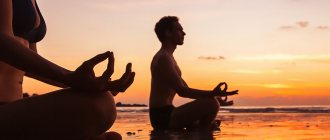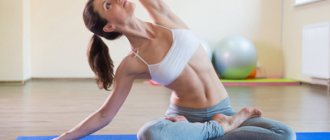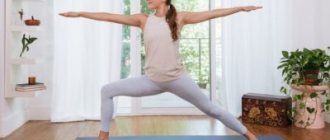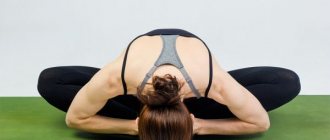Belly breathing is considered the optimal way of breathing, which is why it is common among yogis and athletes.
Observe the breathing of children or animals. You will notice that their entire body is actively involved in the breathing process, their stomach moves in time with their breathing. It is natural for our body to move with our breath.
During abdominal breathing, effective ventilation of the lower parts of the lungs occurs. The intestines and other abdominal organs receive sufficient oxygen, which stimulates their work. Also, massage of the abdominal organs, which occurs during this type of breathing, prevents congestion in the intestines.
The modern lifestyle is contrary to proper breathing. We sit a lot, wear uncomfortable tight clothes, experience stress - all this leads to constrained breathing, without the participation of the diaphragm. Such breathing reduces the efficiency of gas exchange, as a result, the body's cells do not receive nutrients and live in a deficiency mode, which leads to chronic diseases, brain fog and mental dullness.
Conscious breathing using the diaphragm is a breathing technique that allows us to be healthy on all levels.
Belly breathing is also called diaphragmatic or abdominal breathing.
Yoga as a holistic spiritual system.
The practice of yoga is one of the oldest spiritual techniques in the world, with some estimates estimating that the system is 5,000 years old or more.
And if we talk about the tasks that are the basis of this system of exercises, then the improvement of the organism (body) is only one of the aspects and stages along the path of the main goal, which can be roughly described as achieving internal and external harmony of our mind with the world.
Because the goal of yoga is quite complex and in some ways ambitious (although it would hardly be appropriate to talk about ambition in the context of spiritual enlightenment), before starting to talk about breathing, it is necessary to pay some attention to those necessary stages that underlie paths of yoga.
Traditionally they talk about the eight stages of the path of yoga, or otherwise, the eight steps. It is immediately necessary to clarify that, speaking of yoga as a system consisting of steps or stages, there is some danger of misunderstanding, which lies in this.
The fact is that initially yoga is a perfect and holistic system of methods, and if we talk about yoga as a system of spiritual education, then all these methods are absolutely mandatory. The second point is that when we talk about steps, we often imply some sequence of their implementation, but in the case of yoga this is not entirely true.
Of course, some sequence must be observed, so if you came to a yoga class for the first time, then it would hardly be appropriate to expect you to perform all its stages at the same time. But, if a person has already entered the yoga system and has been in it for some time, for example several years, and at the same time he really wants to practice yoga, and not limit himself to just performing asanas, for example, in order to improve his body, then he will necessarily and To the best of his ability, he must pay attention to all stages of yoga. As we have already mentioned, there are eight of them.
Common mistakes and what you need to know
Before starting the exercises, you should pay attention to the theory of breathing practices and especially focus on the mistakes that are often made during training, among them:
- it is necessary to increase the respiratory load gradually, allowing the body to adapt to a larger volume of oxygen;
- all exercises are carried out 4 hours after eating;
- if you have heart disease or a stomach ulcer, it is better to avoid abdominal breathing exercises;
- training must be constant, otherwise there will be no therapeutic effect from the training.
Eight steps of the path of yoga.
1. Pit.
This stage includes the implementation of a system of ethical and moral values and one of the main ones in it is ahimsa
(principle of non-violence) or non-harm to any living beings.
And here we mean all living beings, not just people, which is why vegetarianism is an integral part of yoga.
Please note that the primary goal of vegetarianism here is ahimsa, and not at all maintaining a healthy body.
Satya.
The second part of
yama is true.
This is often thought to mean ethical values of not lying to other people, but this is a limited understanding. In fact, first of all, this means refusing self-deception, because it is one of the main obstacles on the spiritual path, because it is nothing more than ignorance. Asteya.
You should not strive to possess what does not belong to you. And this applies to both material things and personal achievements, for example, you should not pretend to be someone you are not (take someone else’s position).
Aparigraha -
further development of the principle
of asteya
, it says that one should be guided by the principle of reasonable sufficiency, that is, give up the desire to have a position in society or things that are not absolutely necessary.
Brahmacharya.
This is a general principle of abstinence from physical and egoistic aspirations; as a rule, it is understood as the performance of ascetic actions - emotional abstinence, sexual and intellectual.
Any aspect of Yama
can be carried out to the best of your ability, what is important here is your intention, not the result at any cost. The same applies to other stages of yoga.
2. Niyama.
If the previous stage concerned mainly the principles of the activity of the mind, then niyama can be called the consistent embodiment of these principles into action. And this is nothing more than the behavior of a person following the path of yoga.
So, niyama is the implementation of the principles of yoga at the level of personal behavior or conscious action. The basic principles of niyama are as follows.
Shaucha.
This is keeping the body and intestines clean.
Mitahara.
This principle concerns eating the right food, and there are clear instructions in the texts on how a person practicing yoga principles should eat.
Santosha.
The principle that talks about the need to maintain a positive emotional background, this concerns a certain control over emotions. This principle should not be taken too literally and one strives to implement it at all costs, since such an approach can easily lead to self-deception or an attempt to pretend that you are not what you really are. As with everything else, what matters here is your intention to do it, and not achieving the result at any cost.
Swadhiana.
This is a prescription for thinking about the meaning of existence, about your place in it; in addition, svadhiana contains unambiguous recommendations for spiritual self-education - reading sacred and philosophical texts, communicating with teachers and knowledgeable people.
Tapas.
In general, this principle speaks of applying your efforts to carry out the spiritual path or all those actions as a result of which you fulfill the other principles.
Tapas is closely related to the cultivation of our intention, and it refers to the practice of overcoming internal obstacles in yoga.
Ishvara pranidhana.
This is the fifth principle
of niyama , which can be understood as service, or dedication of all one’s actions and merits to the Almighty.
An important part of this principle is to cultivate in oneself a subtle sense (state) of the presence of higher powers, higher meaning and higher wisdom in absolutely everything. 3 Asana.
This is nothing more than a system of the very physical exercises that yoga is usually represented in the West. Each asana represents a certain position of the body in space (you can call it a gymnastic exercise), which, when performed correctly, which includes not only the correct position of the body, but also correct breathing, leads to a special state of consciousness that makes a significant contribution to the advancement of the adept on the path of yoga. A by-product of using asana practice is a healthier body, which is often considered the main goal of yoga in the West.
4. Pranayama.
This is the fourth part of the eight-step path of yoga - a special system of exercises using various breathing techniques. The term itself, translated from Sanskrit, means working with prana, which is understood as vital energy that spreads throughout the body, but is closely related to breathing. According to ancient teachings, prana is the energy that permeates everything and is considered the primary energy of the Universe. Prana spreads throughout our body through a certain system of energy channels, an important part of which are the chakras. Based on these ideas, it is not difficult to understand how much importance is attached to breathing work in yoga.
5. Pratyahara.
This is the stay of our mind in a state not subject to feelings, which are no longer transformed into desires and do not require the adept to constantly satisfy them. In fact, all the previous stages of the eight-step path are preparations that provide this state of consciousness from which what can be called real spiritual practice begins. Pratyahara liberates our being by eliminating the constant need to follow desires and the need to fulfill them.
6. Dharana.
Focus or concentration. By concentrating on one thing, we achieve complete control over the mind, the goal of which is to calm it. When the mind stops mental activity (excitement), it becomes possible for the subject and object to merge into one, through which we achieve the state of meditation or dhyana.
7. Dhyana.
This is a state of meditation or pure contemplation. From now on there is no longer any division between external and internal, between me and not me. Everything becomes one, the sense of self disappears. We can say that all the previous stages were a means to achieve a state of meditation. Which in turn receives its development in the form of the next stage.
8. Samadhi.
As a result of a long stay in meditation, a special state of mind can arise, which is called samadhi and which can be conventionally called superconsciousness. This is sometimes also called the “great death” state during life. However, many teachers refrain from describing this condition because it is considered impossible to talk about it. The state of samadhi and subsequent spiritual death is considered complete liberation from the shackles of samsara, karmic causality and marks the highest goal of the path of yoga.
Breathing practice in yoga.
We have outlined the eight stages of yogic practice and described their meaning, and now we will return to the fourth stage, which is called pranayama or breath work. In general, there are several techniques for working with breathing in pranayama, and despite the apparent simplicity of the recommendations for their use, it is they that cause significant difficulties in understanding on the part of beginners.
The reason for these problems is due to several things:
First, it is quite difficult for a beginner to understand the meaning of these practices. You can describe them as much as you like as harmonization of energy flows of prana inside the body, as a practice of calming the mind, etc., but you can understand the true meaning only in practice, by experiencing this state yourself.
Secondly, it is often very difficult to explain the breathing technique, since initially it is associated with going beyond the usual breathing patterns that we have been accustomed to all our lives.
The third reason is that even after understanding how to do this or that technique, in reality it is not so easy to do it, because these actions, despite their apparent simplicity, have many nuances - which relate to rather subtle points, for example, the depth of breathing, the level of tension in body, observation and control of areas subject to relaxation or, on the contrary, tension, various degrees of observation and control of the breathing itself while performing techniques, as well as what to do if our mind is constantly distracted by extraneous issues not related to practice.
It often begins to seem that in the described situation there is a kind of vicious circle - on the one hand, in order to fully complete the practice, you need to breathe correctly, and on the other, correct breathing can only develop as a result of a well-executed practice.
Of course, there really is no vicious circle and it all comes down to the persistence of you and your teacher, as well as the time you ultimately spend to achieve results. That is, into the practice of patience and overcoming - and this is precisely the part of yoga that relates to tapas .
However, there can be benefit in explaining the situation too much, and we will try to do this, starting with the theoretical aspect of describing the practice of breathing and ending with breathing practices that will help prepare for performing pranayama .
Important
If full yogic breathing causes discomfort at the initial stage, or there is not enough air, the head begins to feel dizzy, you need to stop doing the exercises and return to your normal routine. Breathe freely through your nose or lie on your back and relax in Shavasana (Dead Man's Pose), a classic relaxed position to rest after you've finished a session.
Lie on your back on the mat, legs apart, arms away from your body, and the back of your neck lengthened. Close your eyes and take several long, slow diaphragmatic breaths.
Practice every day. Exercise can help relieve stress, calm your mind, and help you concentrate.
Three types of breathing in yoga.
The first thing to say here is that breathing in yoga means breathing through the nose, but not through the mouth. This is something that needs to be remembered immediately and forever.
In yoga, there are fundamentally three types of breathing - upper, middle and lower.
Upper type is breathing, which is also called clavicular, when a person breathes in this way, he uses only a small part of the lungs, this is a very superficial (shallow) type of breathing. This breathing is called clavicular because it moves the collarbones, ribs and shoulders.
The average type of breathing is intercostal breathing, a characteristic feature of which is the movement of mainly the ribs. Most people, those who do not practice yoga, martial arts, or meditation, breathe in this way.
And finally, the lower type of breathing, which uses the diaphragm muscles. It is this type of breathing that gradually appears in people who engage in sports, yoga and meditation.
Naturally, each type of breathing appears for a reason, but because it is optimal, based on the goals of breathing - saturating the body with oxygen with a minimum of effort.
For this reason, each of the described types of breathing develops as a response to certain external conditions. Thus, in a person leading a passive, sedentary type of life, the lower type of breathing does not develop because there is simply no urgent need for it. And this is despite the fact that this particular type of breathing is optimal for our functioning in all spheres of life.
Lower type of breathing in yoga. Its advantages.
It is this type of breathing that is taught to a person when practicing meditation and yoga, and there are several important rules for performing such breathing.
An important condition is the smoothness of breathing - you need to breathe evenly and without jerking.
It is best to train smooth breathing in a lying position, or shavasana, since this is the only pose that does not hinder movement at all. When training breathing in shavasana, we see that during inhalation the abdominal muscles relax, and the stomach itself inflates like a balloon. During exhalation, we use the diaphragm muscles, which actively push air out of the lungs. The use of these muscles leads to the fact that air is completely removed from the lungs, which cannot happen with the upper and middle types of breathing. Thus, we achieve maximum efficiency when filling the body with oxygen.
Among other advantages of the lower type of breathing, one can note improved blood circulation, a beneficial effect on the nervous system, strengthening the tone of the body and improving concentration; it is also believed that with the active and constant use of this type of breathing, the overall health of the body and its resistance to the external environment are strengthened.
Benefits and harms
Just like any body practice, belly breathing has its advantages and disadvantages. So the benefits of diaphragm breathing are as follows:
- thanks to this type of breathing, a deep massage of the heart, digestive organs, and abdominal organs occurs;
- the state of the immune system improves;
- the process of menopausal syndrome in women slows down, and the functioning of the pelvic organs improves;
- thanks to ventilation of the lungs, they are cleansed from many years of accumulation of dust and numerous harmful substances;
- blood pressure decreases;
- due to the saturation of blood with oxygen, metabolism increases;
- when practicing breathing practices, you can lose extra pounds without resorting to sports;
- Due to relaxation and stress reduction, the thinking process improves and the ability to find new solutions appears.
Yoga breathing techniques for beginners.
Well, now let’s move directly to the yoga practice of breathing.
The first thing we must realize is that learning to breathe correctly is the most important part of yoga and, if you take your practice seriously, then mastering pranayama is an absolutely necessary part of it.
Preparatory exercises.
These are fairly simple exercises that do not require special preparation, but will help you understand how to do lower breathing.
First exercise.
Stand straight with your legs pressed together. Place your palms in a namaste position, with your arms forming a line parallel to the floor. Inhale smoothly through your nose and exhale sharply through your mouth without puffing out your cheeks.
Now we complicate the previous exercise a little and breathe with a delay. We take exactly the same calm breath, then hold our breath for a few seconds and exhale sharply through our mouth.
The same thing, but holding your breath for a maximum - no less than half a minute.
Second exercise. Clearing the lungs.
To do this, you need to sit cross-legged (the lotus position is not required), you can sit not on the floor, but on a yoga wooden brick or on a meditation pillow. It is advisable that your knees touch the floor. Having fully straightened the body (we should feel suspended by the head and shoulders, like a doll), we place the thumb of the right hand in the center of the forehead, and with the middle finger we close the left nostril. We take a quick breath, and then another, but smoother and deeper. Then we exhale smoothly and slowly, using the muscles of the diaphragm - feeling their work. Next, we change hands and perform the same operation.
Third exercise. We feel our breath.
We take the same position as in the previous exercise, only this time we put our hands on crossed legs, you can just put your hands, you can connect them to each other. The body is as relaxed as possible, but at the same time completely straightened - the spine and neck are straight. Essentially, here we alternate between relaxation and tension. Next, we take a slow breath, counting its time 1-2-3..., after counting six times (about 6 seconds), we hold our breath for three counts, then exhale smoothly for 6 seconds. All breathing comes through the nose. While breathing, we try to monitor how we breathe, that is, this is also an exercise for concentration.
Fourth exercise. Belly breathing.
And again we sit in the same position. To perform the exercise you will need a yoga belt. Tighten the belt around your waist with both hands so that it tightly covers your stomach during both inhalation and exhalation, that is, creates constant pressure on the stomach. Then, inflate your stomach so that the belt moves apart, and then, as you exhale, deflate your stomach. At the same time, we constantly tighten the belt so that it compresses the stomach during the inhalation-exhalation cycle. During the exercise, the chest does not move, that is, we fill and empty the lungs only through the diaphragm.
Fifth exercise. Japanese Susokan breathing technique.
To practice breathing and increase awareness as you inhale and exhale, you can try the susokan technique, which is used in Japanese Zen practice. To practice, you don’t have to take the lotus position, just sit in the same way as in the previous exercises. The main thing you need to pay attention to is that your back and neck are straight, and that your knees touch the floor. In this case, your body forms a stable triangle, and the pose becomes stable. You can place your hands on your knees, parallel, or place one palm in the other, so that your hands fall freely onto your crossed legs.
As in the “belly breathing” exercise, we take a slow, smooth breath, inflating the stomach using the diaphragm. Upon reaching full filling, we begin to exhale, very smooth, long and relaxed. We concentrate on the exhalation itself and imagine how all the air smoothly and slowly leaves our body through the hole, which is located about 2 centimeters below the navel.
When we exhale, we gently control the flow of air leaving the lungs, making it completely uniform by controlling the tension of the diaphragm. We perform all breathing using only the muscles of the diaphragm, controlling their tension, while concentrating on the process of exhalation.
We try to exhale all the air completely using the diaphragm. Exhalation is much longer than inhalation. We simply inhale naturally and exhale for as long as possible (10 - 30 seconds).
The exercises listed above need to be done every day, well, if you spend 15-20 minutes on them, this will be enough to feel the first result in a couple of months.
How to breathe while performing Asanas.
While performing asanas, we breathe in such a way that both inhalation and exhalation help us do the pose correctly. To do this, we synchronize the cycles of inhalation and exhalation with stretching and contraction during the asana. The inhalation is mentally directed to the area of the body that is stretching, and the exhalation to the area that is, on the contrary, compressing.
For example, when bending back, the inhalation is directed to the sternum, and the exhalation is directed to the back area. Such breathing promotes concentration during asana, that is, conscious execution of the pose.
Beginning the practice of pranayama.
2-3 years after starting to practice asanas in yoga, you can think about performing another step in the path of yoga - the practice of pranayama. This practice is an important preparatory step on the path to exercises of concentration of the mind, and to some extent, pranayama itself contains elements of this concentration.
If you are serious about yoga, then you cannot avoid practicing pranayama.
We will not give a description of pranayama exercises within the framework of this article; moreover, we strongly do not recommend studying pranayama on your own, for example, from online publications or even video tutorials. This is a serious practice and you need to start it under the guidance of an experienced Master.
Try to find not an instructor for this, but a teacher with at least 10 years of teaching experience.
To prepare for pranayama, you can easily use the set of preliminary breathing exercises given in this article.
The article uses the recommendations of Andrey Maksimenko, one of the most experienced yoga teachers.
How long to do?
For beginners, 1-5 minutes a day will be enough at first. From the second week you can move to 5-10 minutes. After 1-2 months you can do it for 5-10 minutes 2 times a day. Don't rush , it can lead to negative consequences. Master it gradually.
Masters advise practicing this technique for at least 10-20 minutes every day, morning and evening. Having mastered the sitting exercises, you can move on to standing and lying ones. At the same time, while lying in Shavasana, it is recommended to put something flat (a book, for example) on your stomach. This makes it easier to track the movements of the abdominal muscles.
Full breathing is best done with a prepared body. To do this, massage the area of the diaphragm and abdomen with your fingers for several minutes. This will relax the body and set it up for proper functioning.











